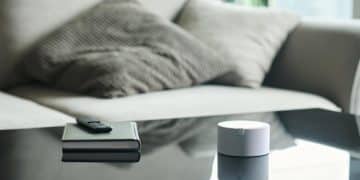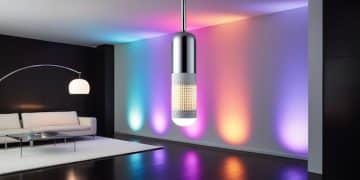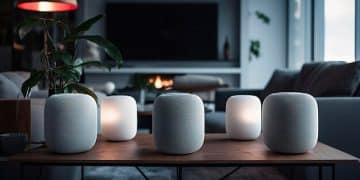Automate Home Lighting: Slash Energy Bills by 20%
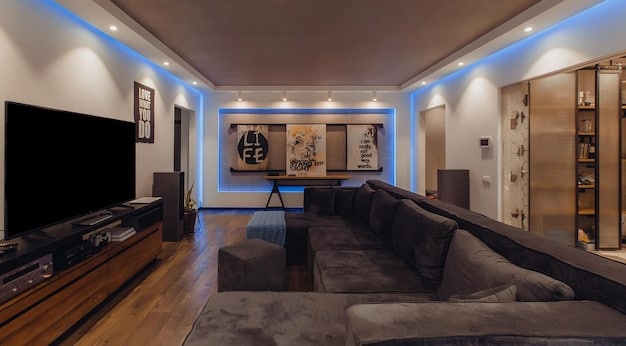
Automating your home lighting can lead to significant energy savings, potentially reducing your energy bills by up to 20% through smart technology and efficient lighting strategies.
Imagine cutting your energy bill by 20% simply by upgrading your home lighting system. With the advancements in smart home technology, it’s now easier than ever to automate your home lighting and achieve significant savings. Let’s explore how you can make the switch and start saving!
Understanding the Basics of Smart Home Lighting
Smart home lighting systems are revolutionizing how we illuminate our living spaces. By upgrading to these systems, homeowners gain unprecedented control over their lighting, leading to both convenience and substantial energy savings. So, what exactly constitutes a smart home lighting system?
Key Components of a Smart Lighting System
A smart lighting system typically includes smart bulbs, smart switches, a hub, and an app for control. Each component plays a vital role in creating a cohesive and efficient lighting network within your home.
Benefits of Smart Lighting
Beyond energy savings, smart lighting offers enhanced convenience, security, and ambiance control. Imagine adjusting your lights remotely, setting automatic schedules, or even integrating with other smart home devices for a seamless living experience.
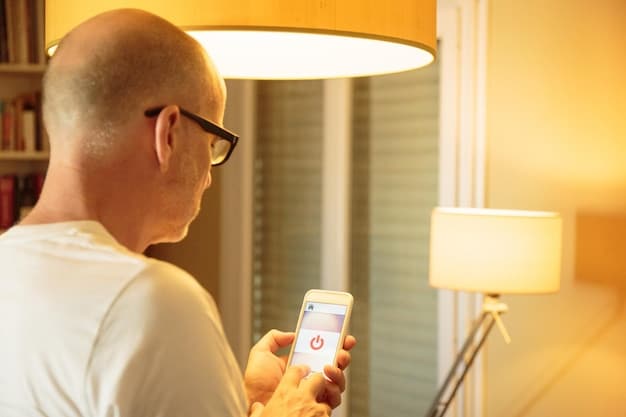
In essence, smart home lighting is about creating a more intelligent and responsive environment. It’s about making your home work for you, adapting to your needs, and ultimately saving you money.
- 💡 Energy Efficiency: Reduce energy consumption with LED smart bulbs and automated schedules.
- 📱 Remote Control: Adjust your lights from anywhere using your smartphone or voice commands.
- ⏰ Customizable Schedules: Set timers and schedules to match your daily routines.
The integration of smart lighting not only modernizes your home but also contributes to a more sustainable lifestyle. The ability to fine-tune your lighting based on your needs and habits can lead to significant long-term savings.
Choosing the Right Smart Lighting System
Selecting the perfect smart lighting system for your home can seem daunting with the myriad of options available. Understanding the key factors to consider will help you make an informed decision that aligns with your needs and budget. Let’s delve into the essential considerations.
Compatibility with Existing Setup
Ensuring compatibility with your existing electrical system and other smart home devices is crucial. Consider whether you need a hub or if the devices can connect directly to your Wi-Fi network.
Types of Smart Bulbs and Switches
Smart bulbs come in various types, including dimmable, color-changing, and standard white. Smart switches can control multiple lights at once and offer a more traditional approach to smart lighting.
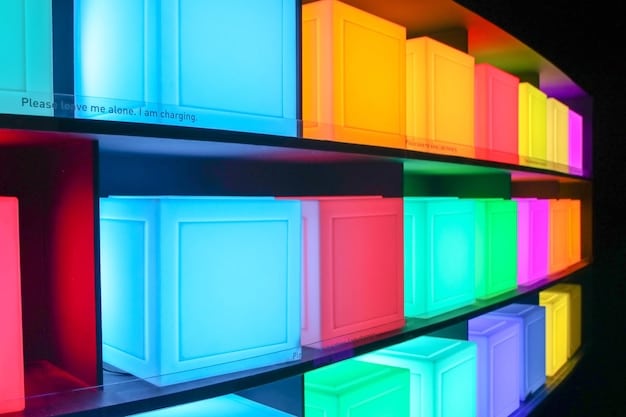
Choosing the right type of smart bulb or switch depends on your aesthetic preferences and functional requirements. Do you want to create dynamic lighting scenes or simply save on energy costs?
- 💰 Budget Considerations: Compare prices and long-term energy savings to find the most cost-effective solution.
- 🏠 Home Size and Layout: Determine the number of bulbs and switches needed to cover your entire home.
- 🎨 Desired Features: Prioritize features such as dimming, color control, and voice integration.
By carefully evaluating these factors, you can select a smart lighting system that provides the perfect blend of functionality, convenience, and energy efficiency for your home.
Installation and Setup: A Step-by-Step Guide
Installing and setting up a smart lighting system is often simpler than you might think. With a few basic steps, you can transform your home into a smart, energy-efficient space. Here’s a step-by-step guide to help you get started.
Replacing Existing Bulbs with Smart Bulbs
The first step is typically replacing your existing bulbs with smart bulbs. This process is as straightforward as changing a regular light bulb. However, ensure that the smart bulb is compatible with your fixture.
Connecting to a Smart Hub or Wi-Fi
Depending on the system you choose, you’ll either connect to a smart hub or directly to your Wi-Fi network. Follow the manufacturer’s instructions for pairing the bulbs with your hub or network.
The ease of installation often depends on the complexity of the system. Hub-based systems may require a bit more setup, but they often offer more robust control and compatibility with other devices.
- 📱 Downloading and Configuring the App: Download the corresponding app and follow the setup instructions to control your lights.
- 🗣️ Integrating with Voice Assistants: Connect your smart lighting system to voice assistants like Alexa or Google Assistant for hands-free control.
- 💡 Testing and Troubleshooting: Test each bulb and switch to ensure they are functioning correctly. If issues arise, consult the manufacturer’s troubleshooting guide.
With these steps, you can quickly and efficiently set up your smart lighting system and begin enjoying the benefits of automated home lighting.
Creating Schedules and Automations for Energy Savings
One of the most effective ways to save energy with smart lighting is by creating schedules and automations. By tailoring your lighting to your daily routines, you can minimize unnecessary energy consumption and maximize savings. Let’s explore how to set up these schedules and automations.
Setting Timers for On/Off Control
Use the smart lighting app to set timers for your lights to turn on and off at specific times. For example, you can set your porch light to turn on at dusk and off at dawn automatically.
Using Motion Sensors for Automated Lighting
Integrate motion sensors to activate lights only when someone is present in a room. This is particularly useful in areas like hallways, bathrooms, and closets.
The key to effective automation is aligning your lighting with your real-world activities. Analyze your daily routines and identify opportunities to automate your lighting based on your presence and needs.
- 🌞 Adjusting Schedules Seasonally: Update your schedules as the seasons change to account for variations in daylight hours.
- 🏡 Geofencing for Arrival and Departure: Use geofencing to trigger lights to turn on when you arrive home and off when you leave.
- 💡 Integrating with Smart Home Ecosystem: Connect your lighting to other smart home devices for coordinated automation.
By intelligently scheduling and automating your smart lighting, you can significantly reduce your energy consumption and enjoy a more convenient and energy-efficient home.
Monitoring Energy Usage and Adjusting Settings
Understanding your energy usage is crucial for optimizing your smart lighting system and achieving the maximum possible savings. Many smart lighting systems offer monitoring features that allow you to track your energy consumption and adjust settings accordingly. Let’s examine how to leverage these features effectively.
Using the App to Track Energy Consumption
Most smart lighting apps provide detailed reports on energy consumption. Use these reports to identify areas where you can further reduce energy usage.
Identifying High-Usage Areas
Pinpoint the areas in your home that consume the most lighting energy. This information can help you focus your efforts on optimizing lighting in those specific areas.
Regularly monitoring your energy usage will provide valuable insights into your lighting habits and the effectiveness of your automation strategies. This data-driven approach allows you to make informed decisions about adjustments and improvements.
- 💡 Experimenting with Different Settings: Try different brightness levels and color temperatures to find the optimal balance between comfort and energy efficiency.
- ⏰ Analyzing Trends Over Time: Look for patterns in your energy usage to identify opportunities for further optimization.
- 💰 Calculating Real Savings: Compare your energy bills before and after implementing smart lighting to quantify your actual savings.
By actively monitoring and adjusting your smart lighting settings, you can continually refine your system to maximize energy savings and create a more sustainable home environment.
Troubleshooting Common Smart Lighting Issues
Even with the best smart lighting systems, occasional issues may arise. Knowing how to troubleshoot common problems can save you time and frustration. Let’s address some of the most frequent issues and their solutions.
Bulbs Not Connecting to the Network
If your smart bulbs are not connecting to the network, ensure that your Wi-Fi is working correctly and that the bulbs are within range of the hub or router. Resetting the bulb and reconnecting it can often resolve this issue.
App Connectivity Problems
App connectivity problems can stem from various factors, including software bugs, network issues, or server outages. Check for app updates, restart your device, and verify your internet connection.
Effective troubleshooting often involves a systematic approach. Start with the simplest solutions and gradually move towards more complex troubleshooting steps.
- 💡 Interference from Other Devices: Identify and mitigate interference from other electronic devices that may be disrupting the signal.
- 🔄 Firmware Updates: Keep your smart bulbs and hub firmware updated to the latest versions to ensure optimal performance.
- 📞 Contacting Customer Support: If all else fails, don’t hesitate to contact the manufacturer’s customer support for assistance.
By being prepared to troubleshoot common issues, you can minimize disruptions and keep your smart lighting system running smoothly, ensuring continuous energy savings and convenience.
| Key Point | Brief Description |
|---|---|
| 💡 Smart Bulbs | Efficient LED bulbs can be controlled remotely to save energy. |
| 📱 App Control | Manage your lights from anywhere using a smartphone app. |
| ⏰ Schedules | Set timers for lights to turn on and off automatically. |
| 💰 Energy Savings | Automation can cut energy bills by up to 20%. |
FAQ
▼
The main components include smart bulbs, smart switches, a smart hub (optional), and a smartphone app for control. Ensure compatibility between these components for optimal performance.
▼
You can potentially save up to 20% on your energy bills by automating your home lighting system. Savings vary based on usage habits and the efficiency of the chosen products.
▼
No, installing a smart lighting system is generally straightforward. Replacing bulbs and following the app’s instructions are the primary steps. Some systems may require a bit more technical setup.
▼
Yes, most smart lighting systems allow you to control your lights remotely via a smartphone app. This feature is useful for security, convenience, and energy management while away from home.
▼
If your smart bulbs lose connection, check your Wi-Fi, ensure the bulbs are within range, and try resetting and reconnecting them. Firmware updates can also help maintain stable connections.
Conclusion
Automating your home lighting is not just a modern convenience; it’s a smart financial decision that can lead to long-term savings and a more energy-efficient lifestyle. By understanding the basics, choosing the right system, and implementing effective schedules, you can easily reduce your energy bills and enjoy the benefits of a smarter home.


